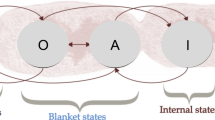Abstract
Most research in the natural sciences passes through repeated cycles of a analytic reduction to the next lower level of organization, then resynthesis to the original level, then new analyticareduction, and so on. A residue of unexplained phenomena at the original level appears at first to require a “holistic” description independent of the lower level, but the residue shrinks as knowledge increases.
This principle is well illustrated by recent studies from the social organization of insects, several examples of which are cited here. In theory it should also apply to human social organization. Culture is biological: meaning in culture can be approached as the outcome of mechanism-based causation, because culture stems from individual cognition, which has a biological basis. It would seem to follow that the most effective way to study culture is across all levels of organization from gene to society, passing repetitively through a cycle of reduction and synthesis in the manner of the natural sciences. Reductionistic analysis is favored by the tendency of semantic memory and culture to occur in discrete units that are arranged hierarchically.
Similar content being viewed by others
References
Alberts, B., D. Bray, J. Lewis, M. Ruff, K. Roberts, and J. D. Watson: 1989, Molecular Biology of the Cell, (2nd Ed.), Garland, New York.
Ayala, F.J.: 1974, ‘Introduction’, in F. J. Ayala and T. Dobzhansky (eds.), Studies in the Philosophy of Biology: Reduction and Related Problems, University of California Press, Berkeley, pp. vi-xvi.
Dawkins, R.: 1988, The Blind Watchmaker, W. W. Norton, New York.
Findlay, C. S. and C. J. Lumsden: 1988, The Creative Mind, Academic Press, London.
Goodman, N.: 1968, Languages of Art, Bobbs-Merrill Co., Indianapolis. IN..
Green, D. M.: 1983, ‘Profile Analysis A Different View of Auditory Intensity Discrimination’, American Psychologist 38, 133–142.
Hölldobler, B. and E. O. Wilson: 1990, The Ants, Belknap Press of Harvard University Press, Cambridge, MA.
Johnston, A. B. and E. O. Wilson: 1985, ‘Correlates of Variation in the Major/Minor Ratio of the Ant, Pheidole dentata (Hymenoptera: Formicidae)’, Annals of the Entomological Society of America 78, 8–11.
Lumsden, C. J.: 1982, ‘The Social Regulation of Physical Caste: The Superorganism Revived’, Journal of Theoretical Biology 95, 749–781.
Lumsden, C. J.: 1985, ‘Color Categorization: A Possible Concordance Between Genes and Culture’, Proceedings of the National Academy of Sciences (USA) 82, 5805–5808.
Lumsden, C. J.: 1986, ‘The Gene and the Sign’, Semiotica 62, 191–206.
Lumsden, C. J.: 1989a, ‘The Gene's Tale’, Biology and Philosophy 4, 495–502.
Lumsden, C. J.: 1989b, ‘Does Culture Need Genes?’, Ethology and Sociobiology 10, 11–29.
Lumsden, C. J. and E. O. Wilson: 1981, Genes, Mind, and Culture,, Harvard University Press, Cambridge, MA.
Lumsden, C. J. and E. O. Wilson: 1983, Promethean Fire, Harvard University Press, Cambridge, MA.
Lumsden, C. J. and E. O. Wilson: 1985, ‘The Relation Between Biological and Cultural Evolution’, Journal of Social and Biological Structures 8, 343–359.
Minsky, M.: 1985, The Society of Mind, Simon and Schuster, New York.
Nagel, E.: 1961, The Structure of Science: Problems in the Logic of Scientific Explanation, Harcourt, Brace and World, New York.
Nathans, J. D. Thomas, and D.S. Hogness: 1986 ‘MatMolecular Genetics of Human Color Vision: The Genes Encoding Blue, Green, and Red Pigments’, Science 232, 193–202.
Oster, G. F. and E. O. Wilson: 1978, Caste and Ecology in the Social Insects, Princeton University Press, NJ.
Schoener, T. W.: 1986, ‘Overview: Kinds of Ecological Communities — Ecology Becomes Pluralist’, in J. Diamond and T. J. Case (eds.), Community Ecology, Harper and Row,New York, pp. 467–479.
Simon, H. A.: 1981, The Science of the Artificial (2nd Ed.), MIT Press, Cambridge, MA.
Sorenson, A. A., T. M. Busch, and S. B. Vinson: 1985, ‘Control of Food Influx by Temporal Subcastes in the Fire Ant, Solenopsis invicta’, Behavioral Ecology and Sociobiology 17, 191–198.
Wheeler, D. E.: 1986, ‘Developmental and Physiological Determinants of Cast in Social Hymenoptera: Evolutionary Implications’, American Naturalist 128, 13–34.
Wickelgren, W. A.: 1979, Cognitive Psychology, Prentice-Hall, Englewood Cliffs, NJ.
wilson, E. O.: 1971, The Insect Societies, Belknap Press ofHarvard University Press, Cambridge, MA.
Wilson, E. O.: 1984, Biophilia, Harvard University Press, Cambridge, MA.
Wilson, E. O. and Hölldobler, B.: 1988, ‘Dense Heterarchies and Mass Communication as the Basis of Organization in Ant Colonies’, Trends in Ecology and Evolution 3, 65–68.
Author information
Authors and Affiliations
Rights and permissions
About this article
Cite this article
Wilson, E.O., Lumsden, C.J. Holism and reduction in sociobiology: Lessons from the ants and human culture. Biol Philos 6, 401–412 (1991). https://doi.org/10.1007/BF00128710
Issue Date:
DOI: https://doi.org/10.1007/BF00128710



